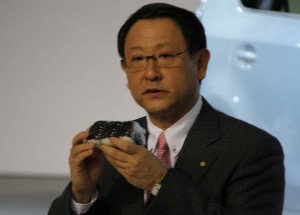Toyota Motor Co. wrapped up one of the worst fiscal year’s in the company’s history with an unexpectedly strong final quarter in which it saw earnings more than quadruple.
Acknowledging the hardships faced since the disastrous earthquake and tsunami – which cost the maker 100s of thousands of units of lost production – Toyota President Akio Toyoda offered a more positive outlook for the future, though he cautioned there are still challenges ahead.
“Thanks to the concerted efforts of our employees, suppliers and dealers, we were able to recover production and sales faster than anticipated and achieved a strong result,” said Toyada, grandson of the automaker’s founder. “Our vision,” he added, “is to establish a strong business foundation that will ensure profitability under any kind of difficult business environment.”
Toyota quadrupled net income to 121 billion yen, $1.5 billion at current exchange rates, during the January to March period, the final quarter in the Japanese fiscal year. Last year’s first quarter felt the first effects of the March 11, 2011 earthquake and tsunami, driving earnings down to just 25.4 billion yen.
For the latest full year that ended March 31, Toyota reported earnings fell 30% to 283.6 billion yen, or $3.5 billion. But that was nonetheless better than the automaker’s original profit forecast of 200 billion yen, or $2.5 billion – and slightly exceeded analysts’ consensus. According to FactSet, the collective forecast for the year had been $3.49 billion.
Sales for latest quarter rebounded 23% to 5.7 trillion yen, or $71.3 billion. For the full fiscal year they came to 18.58 trillion yen, or $232 billion, a 2% drop.
Looking forward, Toyota is now forecasting profits could climb to $9.5 billion for the fiscal year that began on April 1, 2012. In a conference call with reporters, Senior Managing Officer Takahiko Ijichi said the maker expects sales to jump 1.3 million units to 8.7 million cars, trucks and crossovers.
Much of that is expected to come from the restoration of full production following the March 2011 disaster and the concurrent recovery of lost market share. But Toyota also hopes to further build demand with new products – such as the expanding Prius “family” — and by expanding its penetration in both established and emerging markets. During his conference call, Ijichi noted the maker aims to achieve 1 million units of sales in China, up from 900,000 during the just-ended fiscal year.
Regaining share in the critical U.S. market is one of Toyota’s major goals. It scored some successes during the January to March quarter with products like the redesigned Camry and the latest additions to the Prius family, such as the compact Prius C and larger Prius V. The entire hybrid line, starting with the original Prius hatchback, has fared well in the face of rising U.S. fuel prices.
In the last few months,” said Edmunds.com senior analyst Jessica Caldwell, “Toyota has made big strides to regain the U.S. market share it lost to its competitors.”
But data from research firm TrueCar.com has also shown that Toyota has been forced to sharply ramp up marketing expenses – including incentives – to rebuild U.S. demand.
The American fuel price spike has clearly helped the maker, the Prius surging to new records. But whether that pace will be maintained is uncertain. Past cycles show demand for hybrids dips sharply once fuel prices stabilize, as there are signs is now happening.
The automaker also faces challenges due to the strong yen, which has cut into profits in the U.S. and many other parts of the world. Toyota has been attempting to minimize the exchange rate impact by shifting more production of components and vehicles overseas.
That’s a strategy being echoed by its Japanese competitors – notably including Honda, which also showed signs of recovery in its latest quarterly earnings which jumped 61% during the January to March period.
But despite Toyota’s determination to regain its momentum it is facing some equally dogged competitors, including both General Motors – which regained its long-standing position to industry sales leader in 2011 – as well as Volkswagen AG, which landed in the number two slot. VW has a stated goal of becoming the world’s biggest automaker before the end of the decade,
Toyota officials have never confirmed a goal of being – or returning to – number one. But the sales targets for the coming fiscal year show the maker is not going to readily give up that mantle permanently.

